
CEO Secrets Revealed
How I manage my work and mental health
“When I didn’t have systems for organising and managing myself, I lost all of my money and I lost all of my hair.”
This was me, speaking with The BBC as part of their CEO Secrets series.
I’ve always been very open about my experience of losing my hair to stress-related alopecia in the early days of Cognassist, and how it made me adapt the way I work to manage a rapidly growing business and better suit my needs as a dyslexic person.
It’s been incredible to see the response to the article, with lots of people sharing similar personal stories and asking for advice.
It’s been another lesson learned for the business and myself as this outpouring of support and interest has been overwhelming and somewhat (maybe naively) unexpected.
However, we are responding to all the various emails, messages and letters, and I am happy to share my secrets if they could help someone struggling with their workload and mental health in the same way I did.
Given that Cognassist specialises in cognitive assessments and understanding how our brains work, I can confidently say that we all have different ways of thinking, learning and working.
I am very detail-oriented. I have processes for everything, and I use key visual cues and templates to prioritise and organise my work.
You might look at the way I do things and realise it doesn’t suit you.
The key is to understand what does work for you and keep doing it.
This sometimes takes a bit of trial and error, so I’ve taken my specific way of working and created broader steps that you can try out for yourself.
Step #1: Align your actions to goals
I need to have clear visibility of what I’m doing day to day and have a view on how this relates to my wider goals and purpose. So I set and review my goals at various stages:
Annually
Each year, between Christmas and New Year, I review what David Allan of Getting Things Done calls Horizons. Reviewing Horizon 5: purpose and principles, 4: Three-to-five year vision and 3: One-to-two year objectives.
Quarterly
I track my quarters to the company’s financial year. At the end of each quarter, I review Horizons 3: One-to-two year objectives, 2: Areas of focus and accountability and 1: Projects on the go.
Weekly
Each week, I review the prior week’s meetings, projects and actions to plan for the coming week. I work through all meetings during the previous week to make sure I have captured my actions and the major actions of others that I need to monitor in my dashboard.
I’ll then begin to plan out the week by working through my daily process (see below) for each day in the week focusing on what is important to address this week.
The week planning is mainly to address Important issues, and the daily planning includes Urgent ones.
See Eisenhower’s Important / Urgent matrix
Daily
Before every day starts (before I look at emails), I set out the day’s plan, building more detail into the day than I did for the week start (above), given that I know more about the Urgent tasks.
- Meetings – why I am attending and what I need to achieve from the meeting
- Communications – who I need to communicate what to
- Do – actions to address
- Deadlines – this is pre-populated and is a placeholder for me to monitor when colleagues are due to complete a work program that is a dependency of other work
Step #2: Be disciplined with your time
Multitasking is a cognitively exhaustive process and, in my view, is the biggest root cause of ineffective performance. This is even more true for those of us who have significant differences in executive function. So I build in habits to kill anything that hits me during the day and causes cognitive switching.
All audio notifications on my phone are switched off, apart from the ringtone. Email notifications are off and I usually won’t have the inbox visible on screen – instead, I’ll check my inbox before I start the next item of work.
Step #3: Time Enveloping
Time Enveloping is a phrase I made up because I wanted to create a system that separated each segment of time during my day and revealed if I was working to expectations.
I think of it like the magician’s trick, where they write an answer on a piece of paper and put it in a sealed envelope. They go through trick, which might involve members of the audience, and then reveal if the envelope has the predicted answer. The point of the trick is to have the same answer in the envelope as what was predicted.
A good magician will learn from the times when the trick doesn’t work and use it to refine their delivery until the outcome always meets the expectation.
Except my version is perhaps not quite as glamourous…
Each meeting or independent work I do, I Time Envelope by reviewing and rating my time efficiency.
Meetings
At the start of each meeting, I note the start time, expected number of minutes and the Chair/ person who is leading or requesting the meeting.
At the end of the meeting, I add in the total time consumed by the meeting. Then I RAG-rate (Red, Amber, Green) the time spent.

Green = effective
- good pace, stayed on topic, any distractions have been assigned out into other meetings or to report back, decisions have been made, actions documented and SMART.
Amber = requires improvement
- Some poor time or meeting discipline crept in and was not addressed / corrected. But foundations in terms of actionable decisions and approximately correct length of meeting were in place.
Red = ineffective
- Any of: unclear expectations across attendees, few actions or difficult actions; actions that have not been correctly assigned, SMARTed, documented or understood; too much or too little time assigned for meeting; or too many attendees or attendees who were not needed.
An Amber or Red would trigger me to speak to the chair and talk about their understanding of the meeting and why they made some decisions and not others.
Over time, this type of process has established a culture across my business of respecting your colleagues time and raising the bar for effective behaviour.
This goes both ways too – people can and do pull me aside when I have been responsible for meetings they feel were Amber or Red.
Personal RAG of the meeting
After RAGing the meeting time, I RAG whether I was needed at the meeting
- Green = needed throughout otherwise meeting would have been less effective
- Amber = needed but not throughout
- Red = attendance added little to no value
If an Amber or Red, I will work with the chair to understand why they thought I was required and look at my process to sense checking my attendance prior to accepting the meeting.
Sometimes, I can avoid what would be an Amber or Red meeting simply by speaking to the chair prior, talking issues through and letting them hold the meeting without me.
Rate and Review
For operational and regular meetings, we adopt a rate and review at the back end of the meeting.
This involves going ‘round the table’ and asking people to rate the meeting out of 10, each person has 30-45 seconds. Anything below a 10 should include what steps could be taken to improve the meeting. These steps are considered by the chair for the next meeting.
The rate and review encourages transparency across the team and continuous improvement within the organisation. It has been a highly effective method to give everyone in the company a voice to help us improve operationally.
They’re awkward at first and some people felt uncomfortable criticising their peers or managers, but quickly the rate and review process becomes a major value add to the meetings.
As the business scales, this process also helps teams self-evaluate themselves and carry a culture of effective meetings.
In simple terms, it’s a mechanism for real-time, crowd-sourced continuous improvement as the business scales and the challenges shift.
Notes
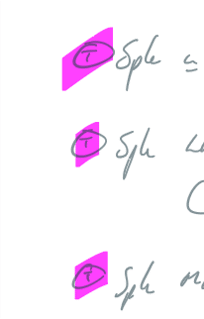
I document my actions with a T in a circle and mark them pink, which makes it easy for me to summarise at the end of meetings and log into my dashboard.

If they’re urgent (that day), I mark them red instead of pink. Again, meaning a quick scan at the end of the day lets me know if I can finish or not.
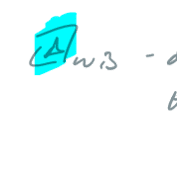
Major actions on others I mark with an A in a square with their initials and the action.
At the end of each day (mostly each day, anyway), I move all T’s and A’s into the dashboard (T’s onto Next Actions or Speak With Internal / External and A’s onto Waiting for Internal / External).
When working independently
When I am working on something on my own, I follow the same time enveloping process as for meetings. This time I consider how long the task should take and put this as the time budget. Then once I complete the work, I review the actual time taken.
As the business grew in complexity, I noticed that the tasks were taking much longer than I had budgeted, meaning I wasn’t planning deliverables realistically.
For about a year, I was underestimating tasks by about 300%.
For instance, something I thought would take 3 hours would take 9. Which would have knock–on effects in terms of my deliverables to others or how many evenings and weekends I had to spend catching up.
After spotting the pattern, I would start multiplying my budgeted time by three. Today I am out by about 100% usually, which means I know something I think will take one hour actually takes two, and I can plan appropriately for that.
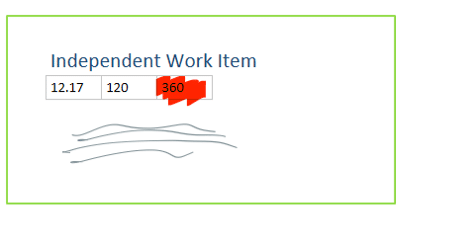
Step #4: The dashboard
Yes, here it is.
There were lots of questions about my dashboard and how it works.
I limit myself to having only 3 systems: calendar, inbox and dashboard. Dashboard is my go to, calendar details commits to other people, inbox is my ‘in-tray’. For me, my inbox can’t be more than one page (no scroll bar visible), and emails are actioned on the dashboard then filed.
I have used David Allen’s Getting Things Done and built a template for Microsoft Onenote that I use week to week:

Let me break it down.
Row 1: Cadence and Quarter Projects
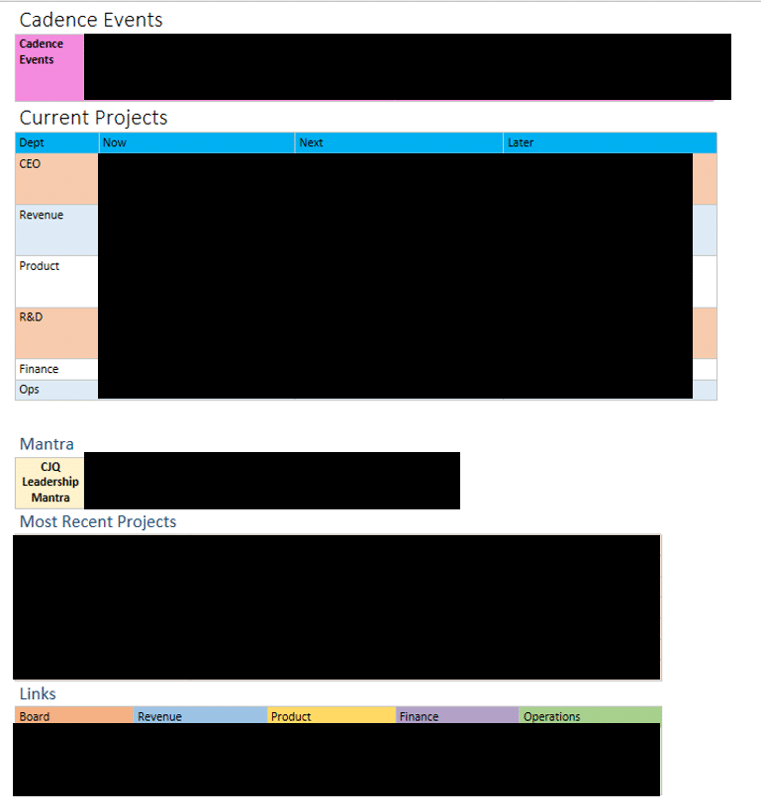
The first column (top left on the dashboard) is a placeholder and links to filing systems for different meetings or projects. My projects are also prioritised in line with the Quarterly Review from the Horizons work.
I use a Now, Next, Later program. Now means this quarter and should be agreed and communicated prior to the quarter starting. I try to avoid anything new entering the quarter’s goals by capturing them and documenting them in Later.
As I move towards the end of the quarter, I’ll start prioritising Later and moving some to Next. Next is finalised at Quarter Review and then moved to Now at the start of the next quarter.
Next actions

The second column is headed by projects owned by other people that I want to keep an eye on. Then I have a bullet list of actions I am responsible for.
Tasks (marked as T in a circle coloured pink) are moved from meeting notes and documented in Next Actions. At the start of each day (Daily process), prioritised Next Actions are copied to the Daily list of Meet, Speak, Do.
Speak with Internal and Speak with External
The third column is a list of who I need to speak to and what I need to speak to them about.
This way, if I am with a colleague, I can check my list of actions to speak with them about quickly. Or if I have 20 minutes between meetings, I can probably cover two “Speak with” actions in the time, so I review the list and make the first call.
There’s no thinking about who I should call about what, as it’s all on the list.
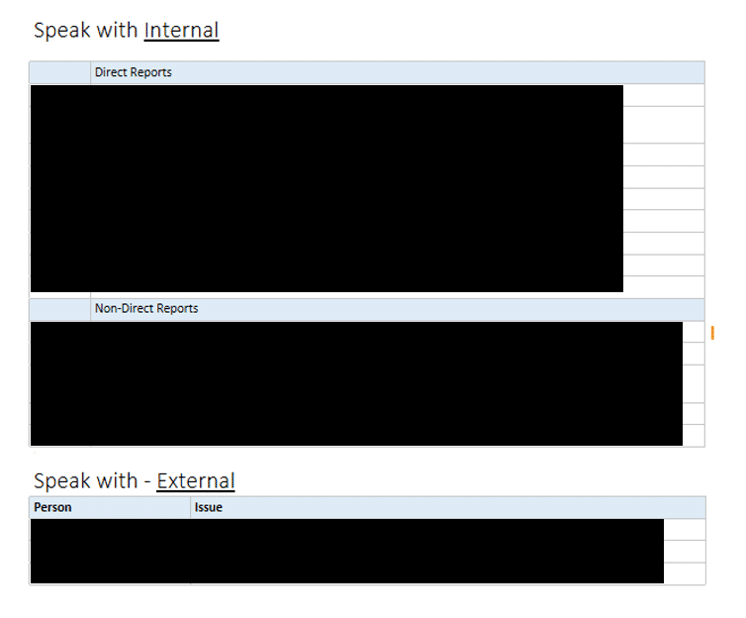
Waiting for Internal and Waiting for External
The fourth and fifth columns in row 1 are Projects I have effectively lost control of as they now sit with others. Who has what activity and when are they expected to complete that work. This is reviewed as part of the Weekly Review and deadlines added to the Daily Actions.

Row 2
These are the daily templates I fill out at the beginning of each day before I check my emails, with one for each day and the Weekend if needed, which thankfully happens less often than it used to.

Row 3
These are all of my notes that contain details of my actions, meeting reviews and projects.
Having this information all in one place helps me feel on top of everything I have to do.
Even when new things get thrown at me, I have a clear process, so I’m much more able to deal with short notice tasks and reprioritise accordingly.
It’s a lot of detail, but these processes and systems are what got me through some of the most stressful years of my life. I 100% couldn’t do my job as effectively without them.
Operational cadence
I have a lot of friends who run businesses and have mentored a lot of founders over the years. I have noticed that many businesses struggle between £2 million and £5 million, not because of the business model but because of a lack of rhythm.
I know because I also struggled around this size until someone introduced me to Gino Wickman’s book Traction.
Traction introduces an operational cadence that Wickman calls the Entrepreneurs Operating System (EOS). If you’re running a business, this book is a must read. I wish I had heard about this book when I founded my first business.
Many of the habits here are also taken from two other books, Steven R Coveys 7 Habits of Highly Effective People and David Allen’s Getting Things Done – both of which I have read more than once.
If you want to embed some of the behaviours in this blog, I’d strongly recommend reading these books, as there is a lot more value in them than I can ever do justice here.
Again, I hugely appreciate the amount of support and interest from people. I hope this provides some practical tips and gives you an insight into how I support my dyslexia in a business environment.
Chris Quickfall
CEO